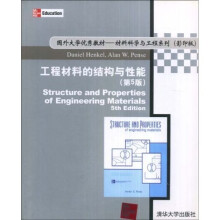SECTION 1
Introductory Materials
Concepts 1
Chapter 1
Structure and Properties
1.1 Atomic Packing 2
1.2 Crystal Structure 7
1.3 Grain Structure 12
1.4 Mechanical Properties and Testine 16
1.5 Physical Properties 26
1.6 Characteristics of Unalloyed Solids 32
Chapter 2
Deterioration of Material
Properties 44
2.1 Fracture in a Ductile Material 46
2.2 Fracture in a Brittle Material 47
2.3 Suppression of Brittle Fracture 49
2.4 Linear Elastic Fracture Mechanics 52
2.5 Property Deterioration at High Temperature 53
2.6 Property Deterioration from Cyclic Loading 56
SECTION 2
Strengthening Mechanisms 59
Chapter 3
Solid-Solution Strengthening 60
3.1 Formation of Solid Solutions 60
3.2 Mechanism of Solidification 62
3.3 Solidification of Pure Metals 65
3.4 Solidification of Metal Alloys 68
3.5 Diffusion 71
3.6 Segregation in Metal Alloys 76
3.7 Real Solid Solutions 79
3.8 General Properties of Solid Solutions 80
Chapter 4
Deformation Hardening and
Annealing 86
4.1 Plasticity of Metals 86
4.2 Property Changes in Deformation-Hardened Metals 95
4.3 Annealing 98
4.4 Property Changes in Annealed Metals 105
4.5 Preferred Orientation and Directional Properties 107
Chapter 5
Multiphase Strengthening 111
5.1 Binary Eutectics 111
5.2 Intermetallic Compounds 114
5.3 Multicomponent Eutectics 115
5.4 Microstmcture of Multiphase Materials 116
5.5 Generalized Properties of Multiphase Materials 124
Chapter 6
Precipitation Hardening 127
6.1 General Mechanism of Precipitation Hardening 127
6.2 Precipitation from Solid Solution 129
6.3 Stages of Precipitation Hardening 131
6.4 Variables Affecting Precipitation Hardening 136
6.5 Precipitation Hardening of Cu-Be Alloys 141
Chapter 7
Martensitic Transformation 144
7.1 The Fe-Fe3C Phase Diagram 144
7.2 Alloys of Iron and Carbon 147
7.3 Microstructure of Nonharclened Steel 151
7.4 Heat Treatment of Eutectoid Steel 156
7.5 The Martensite Transformation 160
7.6 Heat Treatment of Noneutectoid Steels 165
7.7 Physical Property Changes During Martensite Formation 169
7.8 Tempering of Martensite 171
7.9 Microstructure of Isothermally Transformed Steel 173
7.10 Generalized Properties of Heat-Treated Steels 183
SECTION 3
Metallic Materials
Engineering 188
Chapter 8
Low-Carbon Steels 189
8.1 Terms Related to Steelmaking Processes 189
8.2 Grain Size of Steel 191
8.3 Nonhardenable Low-Carbon Steels 193
8.4 High-Strength, Low-Alloy (HSLA) Steels 200
8.5 Welding of Low-Carbon Steel 203
8.6 Surface Hardening of Low-Carbon Steel 206
Chapter 9
Medium-Carbon Steels 211
9.1 Classification of Medium-Carbon Steels 212
9.2 Hardenable Carbon Steels 214
9.3 Hardenable Alloy Steels 216
9.4 Austempering and Marquenching 223
9.5 Ultra-High-Strength Steels 224
9.6 Special Processing of Steel 227
Chapter 10
High-Carbon Steels 230
10.1 Classification of High-Carbon Steels 230
10.2 Heat Treatment of High-Carbon Steels 232
10.3 Cemented Carbides 245
Chapter 11..
Stainless Steels 248
11.1 Phase Diagrams of Stainless Steels 248
11.2 Stainless-Steel Alloy Designations 252
11.3 Heat Treatment of Stainless Steels 253
11.4 Mechanical Properties of Stainless Steels 254
11.5 Corrosion Resistance of Stainless Steels 257
Chapter 12
Cast Irons 263
12.1 Cast Iron (Fe-C-Si) Phase Diagram 263
12.2 Gray Cast Iron Solidification 264
12.3 Ductile Cast Iron Solidification 268
12.4 Concepts of Graphitization in Cast Iron 269
12.5 Properties of Cast Irons 272
Chapter 13
Aluminum Alloys 279
13.1 Work-Hardenable Wrought Aluminum Alloys 281
13.2 Heat-Treatable Aluminum Alloys 282
13.3 Cast Aluminum Alloys 284
13.4 Residual Stresses in Aluminum Alloys 295
13.5 Aluminum-Lithium Alloys 299
Chapter 14
Copper and Copper Alloys 303
14.1 Copper Alloy Designations 303
14.2 Unalloyed Coppers 304
14.3 Brasses: Cu-Zn Alloys 307
14.4 Tin Bronzes: Cu-Sn Alloys 318
14.5 Silicon and Aluminum Bronzes 320
14.6 Cast Copper-Base Alloys 321
Chapter 15
Magnesium Alloys 323
15.1 Magnesium Alloy Designations 323
15.2 The Nature of Magnesium Alloying 326
15.3 Cast Magnesium Alloys 328
15.4 Properties of Magnesium Alloys 337
Chapter 16
Titanium Alloys 342
16.1 Unalloyed Titanium 342
16.2 Phase Diagrams of Titanium Alloys 345
16.3 Heat Treatment of Titanium Alloys 351
16.4 Properties of Titanium Alloys 353
16.5 Applications of Titanium Alloys Problems 359
Chapter 17
Metals for High-Temperature Service 360
17.1 High-Temperature Performance of Refractory Metals 361
17.2 Nickel- and Iron-Base Superalloys 364
17.3 Cobalt-Base Superalloys 370
17.4 Vanadium, Niobium, and Tantalum 373
17.5 Chromium, Molybdenum, and Tungsten 378
17.6 Refractory Metal Coatings 383
SECTION 4
Nonmetallic Materials and
Composites Engineering 386
Chapter 18
Engineering Polymers 387
18.1 Bonding and Structure in Polymers 388
18.2 Generalized Properties of Polymers 394
18.3 Olefin, Vinyl, and Related Polymers 398
18.4 Thermoplastic Polymers 402
18.5 Thermosetting Polymers 405
18.6 Elastomeric Polymers 407
Chapter 19
Ceramics and Glasses 410
19.1 A Ceramic Phase Diagram (AL2O3-SIO2) 410
19.2 Traditional Ceramics: Clay, Refractories, and Abrasives 411
19.3 Structure and Properties of Engineering Ceramics 415
19.4 Characteristics of Glass 416
Chapter 20
Composite Materials 425
20.1 Forms and Properties of Composite Reinforcing Materials 426
20.2 Forms and Properties of Composite Matrix Materials 430
20.3 Metal Matrix Composites 432
20.4 Polymer Matrix Composites 434
20.5 Ceramic Matrix Composites 436
20.6 Carbon and Graphite Composites 436
Index 439

 缺书网
缺书网 扫码进群
扫码进群




